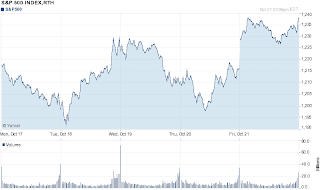On Friday, the S&P 500 rose 0.49 point or 0.04% to 1,285.08. The Dow rose 22.56 points or 0.18% to 12,231.11. For the week, the S&P 500 climbed 3.7%. It is up about 13% this month, and is on pace for its biggest monthly gain since October 1974.
Markets Rally on Euro Zone Deal
The euro zone agreement on Thursday consisted of 3 points. 1) Leverage the EFSF from $440 billion euros to $1 trillion euros. 2) With the agreement of banks, write down Greek debt by 50%. 3) Provide $100 billion euros of funding to European banks. European leaders finally agreeing to a comprehensive deal was a sign of relief for investors.
Troubles Remain for Italy
While the deal was aimed at helping Greece, there was nothing for Italy and Spain. Immediately, troubles appeared for Italy when its 10-year bond yields surpassed 6% for the first time in history.
Is MF Global the Next Lehman Brothers?
MF Global was in the spotlight this week on concerns about funding issues. Its shares tumbled 16.1% on Friday to close at $1.20. Reports indicate that customers were moving money from the futures brokerage. Rumours could lead to a self-fulfilling prophecy that causes the company to become the next Lehman Brothers.
Strong US Economic Data Increases Optimism
On Friday, data showed US consumer sentiment improved in October for the 2nd consecutive month. U.S. quarterly GDP growth of 2.5% also met expectations. With the improving data, JP Morgan raised its 4th quarter GDP forecast to 2.5% from 1%.
Gold Soars on Leveraging of EFSF
Gold rose 6.5% this week to settle at US$1,743.10/ounce. Earlier on Friday, it was at a 1-month high of $1,751.99/ounce. Clearly, the market is considering the leveraging of the EFSF from $440 billion euros to $1 trillion euros as quantitative easing. Thus, while the gold price was weak when the debt crisis appeared the bleakest, it has rallied on a $560-billion-euro QE program ($1 trillion minus $440 billion).
Looking Ahead to Next Week
Looking Ahead to Next Week
Investors will be looking to the G20 meeting in Cannes, France next week. They will be eyeing any effort to stabilize world financial markets. In addition, euro zone manufacturing and services data will be released Wednesday, which could confirm an entry into recession. In the US, employment data will be released Friday, with consensus expectations of 95,000 new non-farm jobs.
While the European agreement has removed a major concern for markets, many headwinds remain. Italy is facing significant problems, and MF Global could be a temporary shock for world financial markets. The market's direction in the next few weeks will be determined by whether the optimism and potentially positive economic data will outweigh the lingering problems.
Investors can expect gold to continue to move up to the $1,800, $1,900 and $2,000 levels in the months ahead. In addition to the market embracing the leveraging of the EFSF as a QE measure, investors expect the Fed to conduct QE3 in the months ahead. This would boost the price of gold even more.





